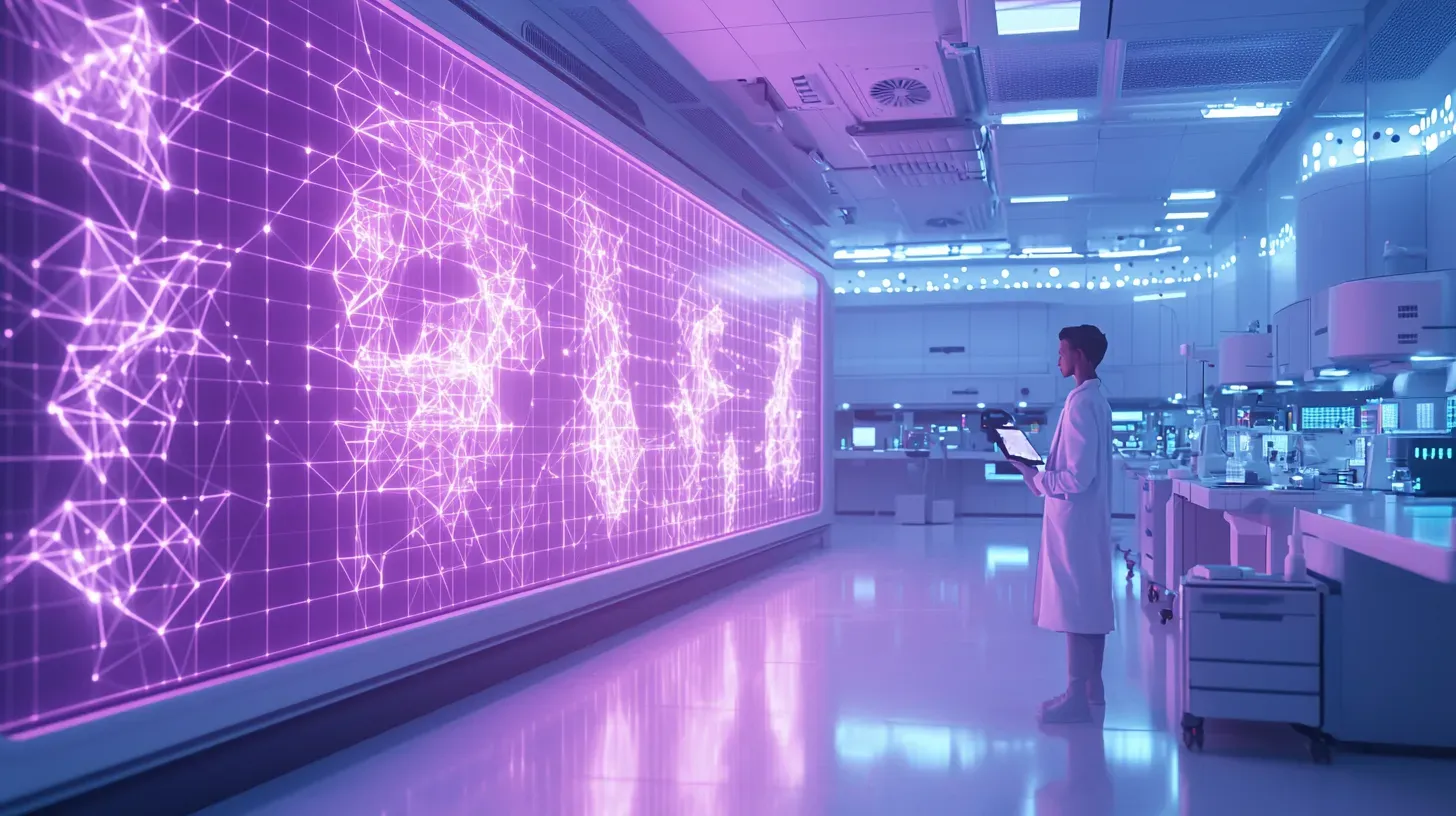Innovation Keynote Speaker: Decoding Computer Vision for You

Innovation Keynote Speaker: Decoding Computer Vision for You
Computer vision, a field of artificial intelligence, has been revolutionizing various industries, from healthcare to manufacturing. It allows machines to perceive and understand visual information, much like how humans do. However, the complexities of computer vision can often leave people feeling overwhelmed and confused. This is where an innovation keynote speaker comes in, bridging the gap between intricate technical concepts and practical applications in a way that is accessible and engaging.
Understanding the Basics of Computer Vision
Before diving into the role of an innovation keynote speaker in demystifying computer vision, let's start by understanding the basics. At its core, computer vision is about enabling machines to analyze and interpret visual data, such as images or videos. By employing algorithms and techniques, computers can classify objects, detect patterns, and make informed decisions based on what they "see."
Computer vision has numerous real-world applications, like autonomous vehicles, facial recognition systems, and medical image analysis. These applications have the potential to transform industries and improve our everyday lives. As technology continues to advance, it becomes increasingly important to have a clear understanding of how computer vision works and its impact on the world around us.
One fascinating aspect of computer vision is its ability to mimic human visual perception. Just like our eyes and brain work together to process visual information, computer vision systems use cameras or sensors to capture images and then analyze them using complex algorithms. These algorithms are designed to recognize patterns, shapes, colors, and textures, allowing the computer to understand and interpret the visual data.
Autonomous vehicles are a prime example of how computer vision is revolutionizing transportation. By using cameras and sensors, these vehicles can "see" the road, other vehicles, pedestrians, and traffic signs. The computer vision system processes this visual information in real-time, enabling the vehicle to make decisions and navigate safely. This technology has the potential to reduce accidents, improve traffic flow, and enhance the overall efficiency of transportation systems.
Facial recognition systems are another exciting application of computer vision. These systems analyze facial features and patterns to identify individuals. They are used for various purposes, such as unlocking smartphones, enhancing security systems, and even assisting in law enforcement. Computer vision algorithms can detect unique facial characteristics, such as the distance between eyes, the shape of the nose, and the contour of the face, to create a digital representation of a person's identity.
Medical image analysis is yet another area where computer vision is making a significant impact. By analyzing medical images, such as X-rays, CT scans, and MRIs, computer vision algorithms can assist healthcare professionals in diagnosing diseases, detecting abnormalities, and planning treatments. This technology not only improves the accuracy and speed of medical diagnoses but also enables doctors to make more informed decisions, leading to better patient outcomes.
As computer vision continues to evolve, its potential applications are expanding rapidly. From augmented reality and virtual reality to industrial automation and surveillance systems, the possibilities are endless. Understanding the basics of computer vision is crucial for staying informed and adapting to the ever-changing technological landscape. By grasping the fundamentals, we can appreciate the immense potential of computer vision and its ability to transform industries, enhance our lives, and shape the future.
The Role of an Innovation Keynote Speaker in Demystifying Computer Vision
Computer vision, with its sophisticated algorithms, mathematical models, and intricate technical details, can be a complex subject to comprehend. That's where an innovation keynote speaker comes in. They possess the unique ability to decode and explain these intricate concepts in a way that is understandable to a wide range of audiences.
Imagine attending a conference on computer vision, filled with jargon and technical terms that leave you feeling overwhelmed and confused. An innovation keynote speaker acts as a translator, breaking down these complex concepts into digestible pieces. They have a knack for captivating an audience and keeping them engaged throughout the session.
One of the key skills of an innovation keynote speaker is their ability to use relatable examples and stories. By incorporating real-life scenarios, they make the seemingly arcane world of computer vision come alive. This not only helps the audience grasp the importance of computer vision but also enables them to envision its potential applications in their own lives.
Moreover, an innovation keynote speaker goes beyond simplifying computer vision. They contextualize it within the framework of different industries, providing valuable insights into how this technology is already transforming fields like healthcare, retail, and manufacturing.
For instance, in the healthcare industry, computer vision is revolutionizing medical imaging. It enables doctors to detect diseases at an early stage, improving patient outcomes. In retail, computer vision is being used to enhance customer experience through personalized recommendations and cashier-less stores. In manufacturing, computer vision is streamlining quality control processes, reducing errors, and increasing efficiency.
By showcasing these real-world examples, an innovation keynote speaker helps the audience connect the dots and understand how computer vision can be applied in their own respective domains. They inspire and empower individuals to embrace this technology and explore its potential to drive innovation and transformation in their organizations.
In conclusion, the role of an innovation keynote speaker in demystifying computer vision is invaluable. They possess the expertise to simplify complex concepts, engage the audience, and provide insights into the practical applications of computer vision across various industries. Through their presentations, they inspire individuals to embrace this technology and leverage its potential to shape the future.
The Impact of Computer Vision on Different Industries
The impact of computer vision extends far beyond the realm of academics and research labs. It has found its way into various industries, creating new possibilities and challenges. Let's explore some of these sectors and how computer vision is shaping their future.
Healthcare:
In healthcare, computer vision is revolutionizing diagnostics, improving surgical procedures, and enhancing patient care. Medical imaging techniques, such as MRIs and CT scans, are being enhanced with advanced computer vision algorithms that can detect abnormalities and assist doctors in making accurate diagnoses. Moreover, computer vision is enabling telemedicine, allowing doctors to remotely monitor patients and provide timely interventions.
Computer vision is also being utilized in the field of radiology, where it aids in the detection of early-stage diseases and helps radiologists analyze complex images. By automating certain tasks, computer vision reduces the burden on healthcare professionals and allows them to focus on critical decision-making.
Retail:
Computer vision is transforming the retail industry, making shopping experiences more personalized and efficient. From cashier-less stores to smart product recommendations, computer vision is empowering retailers to deliver tailored services to customers. It enables the analysis of customer behavior, helps track inventory, and enhances security through intelligent surveillance systems.
One of the key applications of computer vision in retail is in the area of visual search. By analyzing images, computer vision algorithms can identify products and provide customers with similar options, allowing for a more seamless and intuitive shopping experience. Additionally, computer vision is being used to analyze in-store foot traffic, helping retailers optimize store layouts and improve customer flow.
Manufacturing:
In manufacturing, computer vision plays a vital role in quality control, production efficiency, and worker safety. Robots equipped with computer vision can inspect products for defects with unparalleled precision and speed. This reduces the chances of faulty products reaching the market and ensures consistency in production. Additionally, computer vision can monitor worker activities, identifying potential hazards and providing real-time feedback to improve safety protocols.
Computer vision is also being used in manufacturing for predictive maintenance. By analyzing data from sensors and cameras, computer vision algorithms can detect signs of equipment failure before it happens, allowing for proactive maintenance and minimizing downtime. This not only improves overall efficiency but also reduces costs associated with unexpected breakdowns.
Furthermore, computer vision is being integrated into assembly lines, where it assists in guiding robots to perform complex tasks with high precision. This automation not only increases productivity but also reduces the risk of human error.
How an Innovation Keynote Speaker Translates Complex Computer Vision Concepts
Translating complex computer vision concepts requires a blend of technical knowledge and effective communication skills. An innovation keynote speaker possesses both. They have a deep understanding of the underlying principles of computer vision, allowing them to explain concepts in a concise yet comprehensive manner.
But what exactly does it mean to be an innovation keynote speaker? It means being able to take complex ideas and present them in a way that is not only understandable but also engaging and inspiring. It means being able to captivate an audience and leave them with a sense of wonder and excitement about the possibilities of computer vision.
By using relatable metaphors and analogies, an innovation keynote speaker makes abstract concepts more tangible. For example, they might compare image classification algorithms to a team of detectives trying to identify objects based on certain characteristics. This approach helps the audience relate to the subject matter and promotes better retention of information.
Imagine being in the audience, listening to the keynote speaker as they paint a vivid picture of these detectives meticulously analyzing images, just like Sherlock Holmes solving a complex case. Suddenly, the seemingly complicated world of computer vision becomes more accessible and relatable.
An innovation keynote speaker also leverages storytelling to illustrate the practical applications of computer vision. They share real-world examples and case studies that showcase the impact of this technology in action. These stories serve as concrete evidence of its relevance and create a sense of excitement and curiosity within the audience.
Picture yourself sitting on the edge of your seat, engrossed in a story about how computer vision technology helped a medical team detect early signs of cancer in a patient, potentially saving their life. The power of computer vision becomes undeniable, and you can't help but feel inspired by the possibilities it holds.
Furthermore, an innovation keynote speaker understands the importance of visual aids. They utilize compelling visuals, such as interactive demonstrations and eye-catching graphics, to enhance the audience's understanding and engagement. These visuals not only make the concepts more memorable but also create a visually stimulating experience for the audience.
Imagine watching as the keynote speaker demonstrates how computer vision algorithms can accurately identify objects in real-time, showcasing the potential for autonomous vehicles or advanced surveillance systems. The combination of captivating storytelling and visually stunning demonstrations leaves a lasting impression on the audience, igniting their curiosity and driving them to explore the world of computer vision further.
In conclusion, an innovation keynote speaker possesses the unique ability to translate complex computer vision concepts into a language that everyone can understand. Through relatable metaphors, captivating storytelling, and visually stimulating demonstrations, they bring the world of computer vision to life, inspiring and empowering their audience to embrace the possibilities of this groundbreaking technology.
Real-World Applications and Case Studies of Computer Vision
Now, let's take a closer look at some real-world applications and case studies that demonstrate the power of computer vision.
One notable application is in the field of autonomous vehicles. Computer vision enables cars to "see" their surroundings, helping them navigate roads and make informed decisions. This technology has the potential to revolutionize transportation systems, making them safer, more efficient, and less reliant on human drivers.
Another fascinating area is facial recognition. Computer vision algorithms can identify individuals by analyzing their unique facial features. This technology finds applications in security systems, access control, and even personalized marketing. However, it also raises significant privacy concerns, underscoring the need for careful ethical considerations.
Whether it's detecting diseases from medical images, enhancing video surveillance systems, or enabling immersive augmented reality experiences, computer vision is making its mark on society in countless ways.
Conclusion
As we conclude our exploration of computer vision, we realize the importance of having an innovation keynote speaker to decode this fascinating field. They bring clarity and accessibility to complex concepts, ensuring that everyone can understand and appreciate the potential of computer vision.
Computer vision is transforming industries, improving services, and creating new possibilities. By embracing this technology and staying informed about its advancements, we can fully leverage its potential and make a positive impact in our respective domains. So, let's navigate the world of computer vision together and unlock its transformative power.
FAQ
What is computer vision?
Computer vision is a field of artificial intelligence that enables machines to analyze and interpret visual data, such as images or videos. It uses algorithms and techniques to classify objects, detect patterns, and make informed decisions based on visual information.
What are some real-world applications of computer vision?
Computer vision has numerous applications in various industries. Some examples include autonomous vehicles, facial recognition systems, and medical image analysis. It has the potential to revolutionize transportation, enhance security systems, and improve medical diagnoses and treatments.
How does an innovation keynote speaker help in demystifying computer vision?
An innovation keynote speaker simplifies complex computer vision concepts and makes them understandable to a wide range of audiences. They use relatable examples, stories, and real-world applications to engage the audience and help them envision the potential of computer vision in their own lives and industries.
Contact a Innovation Keynote Speaker for your event
If you've found the world of computer vision intriguing and want to bring this fascinating topic to your next event, consider hiring Dr Mark van Rijmenam, an experienced Innovation Keynote Speaker. With his unique ability to decode complex concepts like computer vision into digestible and engaging narratives, Dr van Rijmenam will captivate your audience and leave them inspired by the transformative power of this groundbreaking technology. He will not only enlighten your audience about the potential of computer vision but also provide insights into its practical applications across various industries. To invite Dr van Rijmenam to your event, simply complete the form below and we will be in touch within 24 hours. Don't miss this opportunity to bring a touch of innovation and inspiration to your event.
Thanks for your inquiry
We have sent you a copy of your request and we will be in touch within 24 hours on business days.
If you do not receive an email from us by then, please check your spam mailbox and whitelist email addresses from @thedigitalspeaker.com.
In the meantime, feel free to learn more about The Digital Speaker here.
Or read The Digital Speaker's latest articles here.





